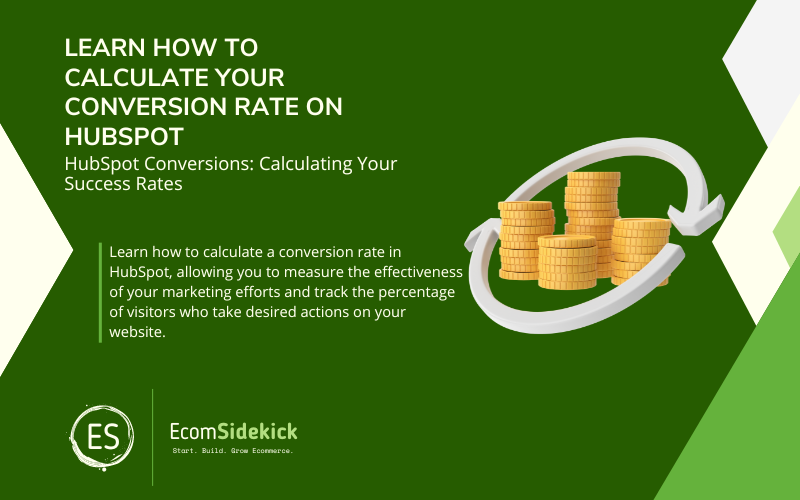Just like HubSpot’s CRM, it directly affects customer relationships. Conversion rate optimization is a challenging task. However, in this article, we’ll talk about how do you calculate a conversion rate Hubspot.
When growing an ecommerce business tools and techniques are invaluable, so as a business owner you have to understand these calculations.

With a set of techniques and practices that will increase the percentage of visitors to a website, convert them into customers or directly impact the action you want in your app or website. Related content: Ecommerce, A Comprehensive Overview of Important Statistics
An Important Marketing Tool: HubSpot
Surely at some point in your life, you have heard of the giant Hubspot. Before we talk about its essential tools, such as rate conversion, CRM, and others, we need to talk about its history, which was and still is very important to the Marketing world.
It was common knowledge that Cold Calling, marketing, and advertising were things for those with a lot of money. This way, smaller startups could not compete in the market on equal terms. However, with the emergence of the Internet, Brian Halligan and Dharmesh Shag observed that the game had turned around, making possible a revolution never seen before.
Hubspot was founded in 2006 by Brian Halligan and Dharmesh Shag at the Massachusetts Institute of Technology (MIT). HubSpot was a finalist in MIT’s solution and business plan competition, receiving an initial investment of $50,000. In 2007 the company grew from $255,000 in revenue to $15.6 million in 2010. And in the same year, Hubspot bought Oneforty, Twitter’s well-known app store.
As per Forbes, HubSpot started focusing on small businesses but changed to serving companies with more than 1,000 employees. And in the year 2014, it was listed on the New York Stock Exchange, reaching historic highs for its shares in 2021.
The Software offered by HubSpot is social media marketing, web analytics, content management, customer support, landing pages, and search engine optimization. There are several resources integrated by HubSpot, such as SalesForce, NetSuite, SugarCRM, and Microsoft Dynamics CRM.
Digital marketing is a fundamental key to success, evidenced by HubsPot’s history of growth and success. You must go far beyond the basics to win customers, build a good customer relationship, and involve excellent marketing material in your campaigns. Hubspot will help us on our way.
Conversion Rate, Definition, and Features
The conversion rate was born from the need for improvement and performance of websites right after the internet bubble burst, which occurred between 1994 and 2000. In this period, the companies started to be more attentive regarding their expenditures, thus investing in an analysis of their sites.
After this burst of the internet bubble, the creation of websites became more straightforward and accessible, resulting in spots that were not well structured, causing a bad experience for the visitor. In this sense, the market competition on the internet started to become fiercer during the early 2000s, with several websites trying to stand out among their competitors.
Online analytics tools allow marketers to study their data on their websites, emails, and more, improving the user experience.
New tools emerged in 2004, giving marketers more accessibility to experiment with alternatives to design, layouts, text, offers, and images, bringing a new face to online browsing. In 2007, the free Google Website Optimizer tool really boosted this market. And nowadays, most marketers use conversion rates to boost their campaigns.
More technically speaking, the conversion rate records the percentage of users who have completed the desired action. This rate is calculated according to the total number of users that “convert.” Dividing it by the total amount of the public that visited your site, we get a percentage. This “conversion” occurs when a visitor clicks on an ad, for example.
Imagine that you are running a mobile ad campaign on Instagram and that the bid was for 10,000 users. Of those 10,000 users, a total of 200 clicked on your ad. In this way, we will be able to get the following percentage:
400/10000 = 0.04, or else a conversion rate of 4%
With this percentage of 4% of users who saw the ad and were “converted,” marketers will design new campaigns to improve their approaches and target audience. In this way, achieving a higher rate of conversion.
From the above, it is clear that the most effective way to get concrete data about your campaigns is a precise rate conversion. When there are multiple advertising channels, this need becomes even more vital.
But don’t think that rate conversions are exclusively about clicks. They can be about several events, such as the percentage of users who performed or canceled a particular action in an application. In this way, significant users can be identified by marketers and advertisers to narrow down the funnel and segment your campaign.
Let’s imagine that the data is showing a lower-than-expected conversion rate. This data can demonstrate some of your users’ problems, like login problems. The effectiveness of your campaign can be established when conversion rate analysis is used correctly, such as which channels are more important for a given app, making every day a more strategic way to make decisions in this environment.
Conversion Rate With Rate HubSpot, How to Start

The vision of leveraging traffic from new customers may be intuitively more appealing. However, as we’ve covered in this article, leveraging existing traffic and leads can propel businesses to long-term sustainable growth. Therefore, conversion rate optimization is essential for your company’s success. Below I will cover some crucial definitions and tips from HubSpot for new audiences.
A conversion rate is the percentage of visitors that are converted through the action you want them to take, such as signing up for a service, buying a product, or filling out a form.
A high conversion rate will mean that your site and campaign are doing well, reaching your target audience. On the other hand, a low conversion rate can mean many things, which can be realized in the site’s design or performance. Suppose the site’s slow loading time. There needs to be a more transparent form or an offer that does not show the product’s value. In that case, these are reasons enough for a possible non-conversion.
But How Do I Know That My Conversion Rate Is Reasonable?
According to the website “Statista,” the average conversion rate for e-commerce sites was 2.17% in the third quarter of 2020, down from 2.37 the previous year. And in the USA, it was 2.57%. Your goals, industry, niche, traffic channel, and audience demographics are all determining factors for a reasonable conversion rate.
This average changes not only by country or year but also by the niche of the survey. The average conversion rate in the food and beverage sector is 5.5%, while in the hair care sector, it is 3.5%.
You need to stick to your niche; if your conversion rate is below your main competitors, it’s time to improve those numbers. Your site is essential for this improvement, as in the homepage, blog, pricing page, chat for direct contact with sellers, and landing pages, among others. So, you must understand that you must improve these items and beyond.
As discussed in the topic “Conversion Rate, Definition, and Features,” there is a general consensus on calculating conversion rate. However, HubSpot provides its subscribers and prospects with a mathematical calculation for further clarification and analysis accuracy.
Mathematical Calculation:
Conversion Rate = Number of Conversions ₓ 100
Total Visitors
As illustrated above, you need to divide the number of conversions by the total number of visitors. You should use this result and multiply it by 100.
Example: you decide to run a newsletter campaign with an apt-in of form fills on your website. If you had 500 submissions and 10,000 visitors in the last quarter, your conversion rate would be 5%. Which would be a significant number.
With this technique, you can see more clearly how well you are doing. However, ensure you only count on the page where you list this campaign. Let’s use one more example. Say you want to calculate your conversion rate for a Smartphone offer; divide the number of purchases by the number of people who visited the offer page.
Calculating the Number of Net New Customers
This calculation is relatively simple but essential. Divide your net revenue target by the average sales price. See below:
New Revenue Target ₌ Number of Net New Customers
Average Sales Price
The Calculation to Find Out Your Leads’ Target
We will get our Leads to target with the data we noted above of net new customer numbers.
Number of Net New Customers ₌ Target Leads;
Total Leads Achieved;
Suppose your website has 20,000 visitors per month, and they generate 200 leads. And subsequently, with 20 customers per month, your conversion rate from the Leads goal would be 1%.
You can even try to get 40,000 visitors to your website and hope your traffic stays the same. But getting more leads from your existing traffic would be more interesting to optimize your conversion rate. This way, you reduce the risks and get more positive results.
Assume that you will try to increase your conversion rate from 2% to 4%. This way, you will double your leads and customers.
Recently, it has been proven that through videos on the “YouTube” video platform, the conversion rate was 52% in one month. These conversions were made directly from the video ads. Thus proving that HubSpot’s integrations with its aggregates, such as AdRoll, can help your business greatly.
C2B is slightly obscure, but it’s a genuine business model. In a consumer-to-business situation, consumers sell goods and services directly to businesses. You can see this business model at work on freelancing sites, where companies hire self-employed people to complete various projects.
Customer Relationship Management (CRM)
Do you know what Customer Relationship Management is? When we study conversion rate, knowing what CRM is crucial. In short, CRM is a set of practices, business strategies, and technologies focused on customer relationships.
CRM goes further in its definition. This is known as a 360º management of marketing, sales, customer service, and all the branches of contact with your customer. It is undeniable that today, we must try to understand new technologies in every possible way due to the latest technologies. As technology has evolved, the relationship with your customers has also grown, leading to the concept of customer experience, which involves strategy, tools, and technologies.
The storage of potential customers’ information is done through CRM, such as their name, phone number, and address. Their contact points with the company and activities are recorded, such as website visits, emails, and phone calls. But make sure that CRM Software is a manageable contact list. The tool integrates valuable data to update the marketing team with information about your customers, such as their purchase history and preferences.
Using CRM With HubSpot
HubSpot defines CRM as “a system for managing your customer relationships.” In that sense, they offer Software to track those interactions, such as with data and notes about your prospects. The HubSpot CRM data is stored in databases accessible by multiple people in an organization.
HubSpot CRM optimizes your sales, customer service, marketing efforts, accounting, and management for growing companies. It can be accessed by several people in one team.
Your potential customer can log into your website and fill out the contact or demo forms. After marketing through emails, for example, you can update information about your customer to see if these emails have succeeded. In this way, marketing can quickly determine how best to gain the trust of your customers.
Some data is entered automatically, while other data can be entered manually. The availability of a system like this will cut down on unnecessary paperwork and bureaucracy, speeding up communication and improving satisfaction.
Even with so many advantages, it is necessary to understand why companies use customer relationship management software. In short, the goal is to improve the customer experience and increase sales.
In a broad understanding, CRM services work very well for exquisite shopping for services. For example, realtors, lawyers, jewelers, landscapers, or even accountants can benefit significantly from the CRM that HubSpot offers. It is vital to reassert that companies with longer sales cycles, such as SaaS, help from this system as well, greatly simplifying the business.
To make sure that your company will benefit from a CRM, we should consider some challenges that CRM is willing to solve, such as:
- Helping you in your productivity and that of your sales teams by establishing a workflow or process to follow.
- Storing all your customer information in a stable and secure system. In a CRM platform, you can create a single data access point for everyone to access. You can save time with multiple data divisions.
- When your customers frequently interact with various people in your company, you will be able to query how the previous interactions went.
In short, with CRM, your company will dispense with obsolete processes and manual activities in your business. It is unthinkable to be tied to yellow sticky notes or outdated technologies. CRM will always be more accessible as far as your platform is concerned and will always keep your team up to date.
In the year 2013, Salesforce, integrated with HubSpot, conducted a survey of 5,200 selected customers. The results will be demonstrated below.
- With the implementation of the CRM platform, you will find more leads and close more deals. According to the survey, the company’s expenses were 37%;
- When your conversations are more people, they become more up-to-date and relevant and can generate up to a 45% increase in customer satisfaction;
- The return on Investment in marketing reported using CRM was 43%.
Final Thoughts

Throughout this article, we demonstrated how to calculate your conversion rate in conventional ways and through the Software in question in the article: Hubspot. With this data, you can clearly see how many of your customers were “converted” to buy some product in some promotion or perform some subscription on your site.
Also note that the amount of net customers is essential for these calculations because, with this data, you will be able to set accurate Leads goals. In this compass, we also discuss improving the relationship with your customers via HubSpot’s CRM.
To improve your conversion rate, remember these valuable CRM tips, like the helpful information you will get from your potential customers, to get better numbers when talking about a good CRM.
Frequently Asked Question
What Is a Good Conversion Rate Benchmark in Hubspot?
The benchmark for a good conversion rate in HubSpot can vary depending on factors such as industry, target audience, and the complexity of the desired action. As a general guideline, a conversion rate between 2% to 5% is considered average, while a rate above 5% is considered good. However, the best conversion rate for your specific business may differ, so it’s essential to compare your performance against your own historical data and industry standards.
Can Hubspot Automate the Calculation of Conversion Rates?
Yes, HubSpot provides automation features that can help you track and calculate conversion rates automatically. By setting up conversion goals and tracking events within HubSpot, the platform can capture and calculate conversion rate data in real-time. This automation saves time and allows you to focus on analyzing and optimizing your marketing efforts.
What Is a Conversion Rate in the Context of Hubspot and Inbound Marketing?
In the context of HubSpot and inbound marketing, a conversion rate refers to the percentage of website visitors who take a desired action, such as filling out a form, subscribing to a newsletter, or making a purchase. It is a key performance indicator (KPI) that measures the effectiveness of your marketing efforts in converting visitors into leads or customers.
Paul Martinez is the founder of EcomSidekick.com. He is an expert in the areas of finance, real estate, eCommerce, traffic and conversion.
Join him on EcomSidekick.com to learn how to improve your financial life and excel in these areas. Before starting this media site, Paul built from scratch and managed two multi-million dollar companies. One in the real estate sector and one in the eCommerce sector.

